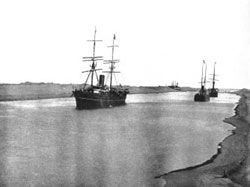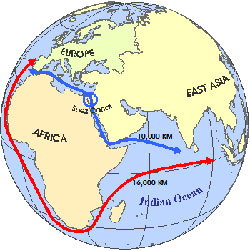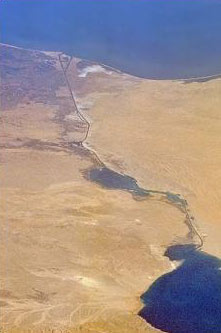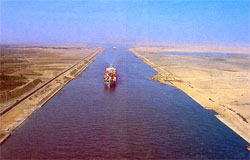Feature – Suez Canal
Heading north through the Red Sea, passing the Port Towns Safaga, Hurghada and Ras Gharib, you are greeted by the Gulf of Suez, the opening to the Suez Canal.
While the Waterway itself is less than splendid, the promise of where this historic stretch of water will take you and the history that flows within its banks make the Suez Canal a very special place indeed.
Although the Suez Canal was officially opened in 1869, the concept for one of the world’s most famous waterways and engineering feat goes back quite some time.
Lets start way back in the 7th Century B.C. in which a not so compassionate individual, a certain Egyptian King called Necho II (619-595 BC), attempted to create a waterway between the Red Sea and the Mediterranean. The project was a total disaster and the King decided to abandon all further efforts, but not before an unbelievable 120,000 slaves lost their lives. Such a tragedy.
Heres what followed in the year 522 B.C. Just after the Persians had ousted the Egyptians. King Darius (very important chap) announced that whatever work had been started on the Canal, he would finish and hence reap all the glory.
King Darius linked the Red Sea and the Great Bitter Lake (not such a bad idea). Then this was further connected to an already existing waterway that had been put in place by no other than Ramses II. This canal connected via Bubastis (known well for its feline mummies) on the Nile and then eventually flowed to the Mediterranean.
King Darius was not really up for the challenge and in engineering terms things did not really work out. Read on……
Greek Daily Times
Monday 1st April
5th Century Edition
King Darius today announced the opening of the “Suez Canal”. What is this guy thinking? The general opinion of those using this so called “Super Waterway” is that it is a little off course and not the most direct route between the Red Sea and the Mediterranean. And if this is not enough, it is barely wide enough for two Triremes to row side by side. I would hate to be anywhere near this place on a Bank Holiday. What a disaster waiting to happen!!
Written By
Herodotus
Well as if Herodotus had some amazing insight into the future of King Darius’s claim to fame, the news of the canals outcome would have left egg on the face of Darius himself.
The waterway was later improved by the Romans, who did their best with the not so impressive canal. However, it was not long before the canal silted up and was eventually abandoned.
Talk about illusions of grandeur. Other famous kings and leaders also had big ideas to make the Suez Canal a happening thing. However, it was not meant to be and efforts by the Venetian Empire’s very own King Louis XIV, the Crusaders, the Ottomans and even Napoleon himself dwindle to nothing.
Well we know that was not the end of the Suez dream and here is what happened next.
Now in 1854, a very clever fella, a French diplomat named Ferdinand de Lesseps was obviously paying attention in class. He had noted that past plans for the canal showed a rather large discrepancy in the sea level between the Red and Mediterranean Seas. In fact a VERY BIG 30 foot discrepancy (9.1m). This had disaster written all over it and so it was time to rethink and put a new strategy into place.
It just so happened that the viceroy Muhammad Said Pasha (another high ranking individual of his time) was a man that wanted the Suez Canal sorted once and for all.
So Ferdinand ceased the moment and got the thumbs up to commence work on the waterway that would follow the more direct route north through the town of Suez, into the Bitter Lakes and all the way home to the Mediterranean Sea. Greeeeeeeeat!
So for the next ten years it was work, work and more work. Ferdinand sure put some elbow grease into this venture and had a “Never Say Die” attitude, which meant that his glass may have been full of sand, but at least it was half full of sand and not half empty.
The completed Canal was really something else. It was an impressive 100 miles (161 km) long, 50 feet (15.2 m) deep, and 450 feet (137 m) wide at the top, with passing bays every 6 miles (10 km). You would certainly need a few buckets and spades to get this happening at your local beach.
It would be fair to say that on the flipside of Ferdinand’s dedication and enthusiasm for the job, the Suez Canal project had a dark and somewhat cursed track record. It would have been nice to have left you with a happy ending to this history lesson, but with the loss of life that followed through accident and disease and though the many individuals who where made bankrupt by the sheer cost of creating the Suez Canal, this does not make for any fairytale.
“What next?” I hear you say.
Well in 1875 amid the depths of despair and confusion the Prime Minister Disraeli nipped in really quickly and purchased the shares of the majority shareholder ‘Ismail’, who had been one of the more unfortunate casualties of the Suez project. Ismail had very little choice but to sell his 6.5 million pound investment at quite a loss. Hence the Imperial concession became the major shareholders in the Suez Canal and Queen Victoria was as pleased as punch.
Well apart from being another conquering success for the Brits, the Suez Canal also generated huge amounts of cash and that was really what drove the project from beginning to end.
During the two world wars the Suez Canal was transformed into the largest military base of the planet. The region saw some major military action during this period of world unrest, but also as if the canal’s history was not sad enough more was yet to come.
The British presence in the region was starting to cause tension and before long things where taking a turn for the worse. The British lead an assault on Ismailiya’s police barracks and the outcome was less than pretty. This attacked created a snowball affect, with riots and overall unrest throughout the region.
After the revolution of 1952 the new Egyptian leaders demanded that the British forces leave their country. This demand was shortly followed with another, to include greater share of the revenue created by the Suez Canal. (Well, you can only ask).
Things went from bad to worse and in 1956 when the West refused to make loans to finance the Aswan High Dam, Nasser announced the Suez Canal’s nationalization. (well you can imagine what a result this caused). Britain and France kicked up a big stink and name calling commenced. The Israeli’s ceased this opportunity to advance into Sinai under the guise that they where there to protect the canal. The reality was that they invaded and destroyed the canal towns and cities. What followed was later named the Suez Crisis and the outcome lead to a victory for Nasser.
But wait there’s more….
In 1967 just as the region thought that things were looking up the war with Israel reared its head and caused major damage and destruction, leaving the Suez Canal to become a graveyard for destroyed vessels. The Canal was closed for obvious reasons and the Suez was evacuated. The entire region remained unstable on and off for several more years, until the Canal was reopened for shipping in 1975.
The two waring sides remained steadfast and until 1982, when Israel decided that they should withdraw from Sinai.
Unfortunately during the time of closure of the Canal it was decided by other countries that other cost effective ways of transporting cargo between the two regions would have to be created. Along came the Super tankers, designed to be able to travel around the coast of Africa. Of course the Suez Canal had never been designed to handle such vessels. And so on reopening, the Canal traffic was vastly reduced.
Well things at last stabilised in the region and the Suez Canal now sees 14% of the world’s trade sailing up and down it’s waters.
From beginning to end this vision of man’s to see the ill fated Suez project to frutation is now at last a reality and for all it’s subtleties and understatedness the Suez Canal really is a wonder of our world.
Join us soon for another Feature.




